
|

|
|
Home Site Search Contact Us Subscribe
|
|
|
Field Notes from the 11th Venice Architecture Biennale - Part 1 The Arsenale: Betsky's eclectic curating and the polished and thoughtful presentations of the exhibitors make it a challenging, entertaining, and provocative show. By Terri Peters October 10, 2008 The two straight days of thunderstorms did little to dampen spirits the opening weekend of the 11th Annual Venice Architecture Biennale, which runs until November 23, 2008. This year’s show is curated by architect and writer Aaron Betsky, the former head of NAI Rotterdam, who now lives in Cincinnati where he is director of the Cincinnati Art Museum. The theme of the Arsenale, a series of warehouses on the industrial waterfront, one of the two main exhibition areas (the other being the Giardini, a short walk away) is “Out There: Architecture Beyond Building.”
Betsky argues that buildings are not architecture – that “buildings are buildings; architecture is something different.” The theme is illustrated throughout the show, and explained further by Betsky in the accompanying catalogues, and also in the short film about the making of the Biennale, where he takes the viewer on a tour of the Arsenale as it is being set up for the exhibition. “Architecture is everything that is about building. It is how we think about building, how we draw buildings, how we organize buildings, how buildings present themselves, through façades, interiors,” he explains. “These days, buildings are designed not by architects, who make architecture, and not to be architecture, but to be cheap and easy and efficient.” You can almost imagine architects around the world cheering. “They are designed by codes – building codes, safety codes, so you get in and out safely, by codes of how things are placed, by conventions, by financial codes that tell you how much things can cost – get things as cheaply as possible – and finally, of course, by computer codes, which standardize everything so that the architect is almost forced to make the most efficient buildings. Architecture is very difficult to find.”
He has succeeded in finding architecture at the Arsenale, rather than buildings in his exhibition, from the movable steel field of Barkow Leibinger’s “Nomadic Garden” and Golden Lion winner Frank Gehry’s deconstructed timber assemblage to Gustafson Porter’s “Towards Paradise” garden. Betsky’s message that “buildings” are killing “architecture” is well timed. As the world braces for an economic downturn, the idea of architectural experimentation and paper architecture is compelling. With budgets slashed and design seen more and more as something to be “value engineered,” architects should be worried about the state of the profession. Now seems the time for reflection and contemplation on the manic building sprees every nation’s cities have endured for the past decade or more. The boom of cities and the impact of technology on modern life are well worked concepts in architecture exhibitions, but Betsky’s eclectic curating and the polished and thoughtful presentations of the exhibitors make it a challenging, entertaining, and provocative show.
The Arsenale exhibition begins with one of the best works on show, the “Hall of Fragments” installation by David Rockwell with Jones|Kroloff. A thin, full-color booklet devoted to this installation is part of the set of Biennale catalogues, which overall are the best in recent years, with brilliant graphics and layouts by Dutch design firm Thonik. In “Hall of Fragments” the focus is on films as the source of many architectural and city inspirations. The installation is an immersion into a cinematic environment with room sized cinema screens, small screens, sounds, and lights creating a theatrical space. From Fritz Lang to “The Truman Show” to “Jaws,” the films are recognizable and make viewers think that this virtual world that we imagine architecture in is not limited to buildings – it is imagination.
Diller Scofidio + Renfro’s Chain City is another installation about film, but on a much smaller scale, with wrap-around screens showing scenes of Venice. It takes the viewer a few minutes to realize the screens show assemblages of canal tours about the idea of Venice, not so much the geographic location. The short films were shot in Venices around the world, from Venice, Italy, to Venice, Las Vegas. “Since the days of the grand tour, Venice has been the consummate tourist destination,” argue the designers, “with Venices springing up in Las Vegas, Tokyo, Nagoya, Macau, and Doha, Venice may be a city fixed in time but fluid in space.” The playful installation suggests the nature of memories, tourism, nostalgia, and travel are not as straightforward as they seem.
Other highlights of the Arsenale are Greg Lynn’s recycled plastic toys transformed into furniture that he calls “first generation prototypes of high technology scavenging of recycled plastics.” They are welded, melted, moulded forms that still look like mutated toys and show a playful and vividly colored way of “being at home in the modern world,” which is what Betsky assumes we all want and that we can use architecture to achieve this sense of home.
The nearby “Lotus” installation by Zaha Hadid looks anything but homey. It’s a sleek, high-gloss, room-sized piece of furniture with various alcoves and swooping forms potentially indicating different functions. Dubbed by Hadid and Patrik Schumacher as “a Russian matryoshka doll performing a striptease,” the form looks anything but sexy to me, although maybe it is a wooden doll’s interpretation of a seduction. It may be if visitors could see its flexible nature rather than its static pose, its ability to transform and move would be more apparent. “Rather than represent an already domesticated system of interior standards, the Lotus room seduces through its undulating rhythmic folds, its exclusions, its re-configurability, and ability to remain uncharacterized,” Hadid explains in text accompanying the exhibition. Roped off so visitors can view its precious and hardwearing (but susceptible to scratching) form, it looks hard, mean, and cold – but perhaps ideals of “home” are changing, and this a different way of being at home (for robots).
Cooler than Hadid’s “Lotus,” or perhaps warmer, depending on your position, Philippe Rahm Architects, always big on the experience of architecture (Rahm is known for his designs for pheromone paint which could create an environment that makes people want to have sex) presented the “Digestible Gulf Stream” – an invisible landscape of extreme temperatures prepared spicy or minty. “Here two horizontal metal plates are extended at different heights,” he explains. “The lower plane is heated to 28 degrees and the upper one is cooled to 12 degrees. Like a miniature gulf stream, their position creates a movement of air using the natural phenomenon of convection in which rising hot air cools on contact with the upper cool sheet, and, falling, is then reheated on contact with the hot sheet, thus creating a constant thermal flow.”
After Rahm’s gulf stream, if visitors then walk back to Coop Himmelb(l)au’s “Feed Back Space,” they can venture inside the futuristic clear bubble environment designed to monitor and respond to heart rates. By clutching what seems like joy sticks, the sensors read the heart rate and the bubble environment responds with color that is transformed onto the bubble membrane. Conceived of in 1969, Coop Himmelb(l)au finally realized their dream of making this machine: “To this we added only the dream of poetry: the city beats like a heart – the city flies like a breath.”
Betsky questions what architecture is good for, why we need it, and why we want it. He’s advocating a big shake up, a change to the way we think about architecture and the modern world. His message is clear, but are architects willing to move beyond buildings?
Terri Peters is a writer and designer based in London. She writes about art and architecture for magazines such as Frame, Azure, Mark, Clear, and The Architect’s Journal.
Also by Terri Peters:
Architecture
Supermodels: Report from SmartGeometry Conference
Exhibition Review:
"The 60s: Montréal Thinks Big" at the Canadian Centre for
Architecture
Exhibition Review:
"RED + WHITE: Canadians in Design" at Canada House, Trafalgar Square,
London
|
(click on pictures to enlarge) 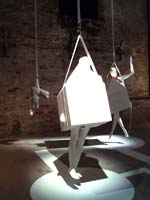 Terri Peters Droog’s Singletown looks a bit scary – strung up from the ceiling, gleaming life-size models hover, casting ominous shadows. 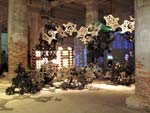 Terri Peters Matthew Ritchie and Aranda Lasch of Aranda\Lasch designed their “anti-pavilion” as mutating, intersecting parts that are demountable, portable, interchangeable, and recyclable 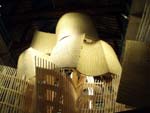 Terri Peters Frank Gehry’s timber collage (like his Serpentine Pavilion in London) is suitably impressive and “liberated from the box” in this grand space 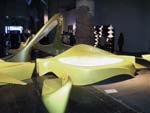 Terri Peters “Lotus” is signature Hadid; the fluid, hard, and shiny forms are a prototype environment that could be a room, a house, or a piece of furniture 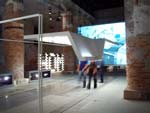 Terri Peters Philippe Rahm’s “Digestible Gulf Stream” challenges architecture to take on global warming in this installation of architecture as thermal interface 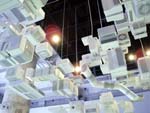 Terri Peters An Te Liu’s air purification installation called “Cloud” looks at questions of future inhabitation of buildings. He asks, “What will our brave new world be like? Clean at least.” 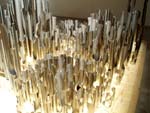 Terri Peters Barkow Leibinger’s “Nomadic Garden” invites visitors to rearrange the clustered landscape of metal tubes 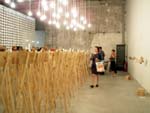 Terri Peters The Chilean installation “I was there,” curated by Mauricio Pezo, is a playful look at tourist trinket as emblems of local identity  Terri Peters The Centre for Contemporary Architecture in Russia brings to the Arsenale the nomad’s yurt, and the nomad’s new car mixed together 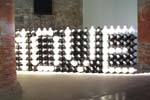 Terri Peters Thonik designed these mysterious plastic modules that appear throughout the Arsenale and on all the Biennale graphics, leading many to wonder who did them and what for? |
© 2008 ArchNewsNow.com